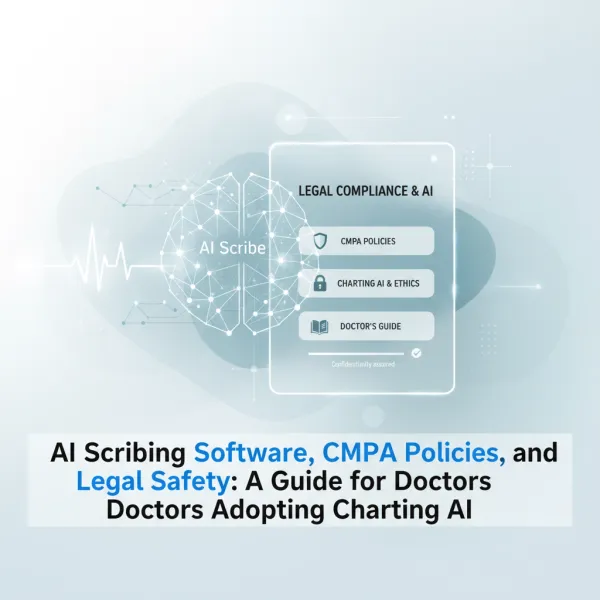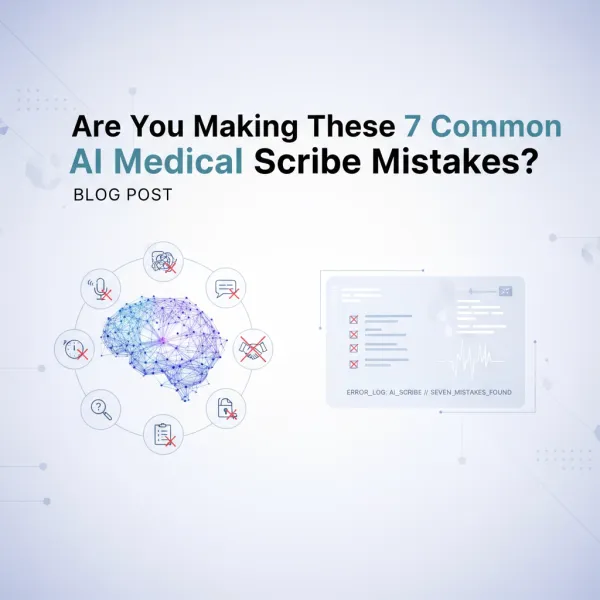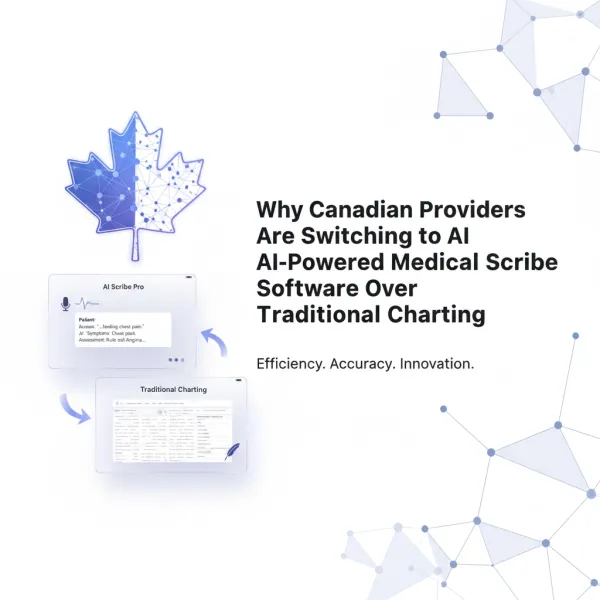AI vs Traditional Medical Scribing: A Cost Comparison
Explore the cost benefits of AI medical scribes over human scribes, highlighting efficiency, scalability, and potential savings for healthcare practices.

Healthcare providers are choosing between AI medical scribes and human scribes to manage growing documentation demands. This decision impacts costs, efficiency, and scalability. Here's the key takeaway: AI solutions reduce costs by 60-75% compared to human scribes while improving efficiency.
Quick Overview:
- Cost: AI costs $99-$299/month per provider; human scribes cost $32,000-$42,000 annually.
- Scalability: AI scales instantly; human scribes require hiring and training.
- Speed: AI completes notes in 1 minute vs. 15-30 minutes for humans.
- Error Rates: AI error rates range from 5.6%-26.9%; humans average 7.4%.
- Savings: Practices using AI save up to $1 million annually from reduced errors and increased efficiency.
Quick Comparison:
| Feature | AI Medical Scribes | Human Medical Scribes |
|---|---|---|
| Cost | $99-$299/month | $32,000-$42,000/year |
| Scalability | Instant | Requires hiring/training |
| Speed | Instant | 15-30 minutes per note |
| Error Rate | 5.6%-26.9% | 7.4% |
| Initial Setup Costs | $0 | Hiring Costs |
| Monthly Costs (5 Providers) | $595-$1,795 | $16,500-$30,000 |
AI scribing is more cost-effective, scalable, and faster. However, balancing AI with human scribes may work better for complex cases or specialty practices. Read on for a detailed breakdown of costs, efficiency, and long-term benefits.
Cost Breakdown: Setup and Monthly Expenses
Initial Investment Costs
When comparing startup costs, the differences between human scribes and AI solutions are clear. AI systems typically require no upfront investment. On the other hand, human scribe programs for a 5-provider practice can cost between $20,000 and $45,000, largely due to recruitment and equipment expenses.
| Expense Category | Human Scribes | AI Solution |
|---|---|---|
| Initial Setup | $2,000-$5,000 per scribe | $0 |
| Equipment | $500-$1,000 per scribe | Included in setup |
| Total (5-provider practice) | $20,000-$45,000 | $0 |
Monthly Operating Costs
Monthly expenses also show a sharp contrast. AI medical scribing solutions cost between $99 and $299 per provider each month, covering software updates, maintenance, and technical support. In comparison, human scribing programs come with significantly higher costs, including:
- Benefits packages (20-30% of a scribe's salary)
- Ongoing training expenses ($100-$200 per month)
- Management overhead for coordination and supervision
For a 5-provider practice, here's how the monthly costs stack up:
| 5-Provider Practice Monthly Costs | Human Scribes | AI Solution |
|---|---|---|
| Base Costs | $15,000-$26,000 | $495-$1,495 |
| Additional Overhead | $1,000-$3,000 | $0 |
| Training/Updates | $500-$1,000 | Included |
| Total Monthly | $16,500-$30,000 | $495-$1,495 |
Human scribe programs also face hidden expenses, like attrition costs, which can range from 50% to 150% of a scribe's annual salary for replacements. In contrast, AI systems have predictable fees for high-volume users, typically $100 to $500 per month. Scaling up a human scribe program adds another layer of expense, with $30,000 to $50,000 annually per additional scribe for salary and benefits, plus $2,000 to $5,000 for recruitment and training[9].
These cost differences highlight the financial implications of choosing between human scribes and AI solutions, especially when factoring in speed and efficiency.
Speed and Output Comparison
Availability and Processing Speed
The speed at which AI operates offers clear financial benefits, helping to balance out the initial setup costs. For example, while human scribes take about 15-30 minutes to complete a patient note, AI systems can handle the same task in just 2-3 minutes. This is possible because AI performs real-time transcription and organizes data during patient visits.
| Processing Metric | Human Scribes | AI Solutions |
|---|---|---|
| Note Completion Time | 15-30 minutes | Instant |
| Concurrent Cases | 1 patient | Unlimited |
Income from Time Savings
The time saved per encounter has a direct impact on revenue. By cutting 6-8 minutes from each visit, providers can see 2-3 additional patients daily. This translates to an extra $750 in daily billings per physician, which could amount to $125,000-$200,000 annually, depending on the specialty and patient load.
Beyond financial benefits, AI solutions help reduce physician burnout. By cutting after-hours charting by 30-40%, doctors save 1-2 hours a day that would otherwise be spent on documentation[2][3].
Error Rates and Financial Risk
Accuracy Rates and Cost Impact
Speed may drive potential revenue, but accuracy in documentation directly impacts financial risk. Human scribes typically have a 7.4% error rate, while AI medical scribes show error rates ranging from 5.6% to 26.9%, depending on how well they’re implemented [1]. These errors can lead to costly outcomes, especially in medical billing, where 26% of claim denials result from missing or incorrect patient details [2].
The financial fallout from errors includes:
- Hospitals spend an average of $118 to rework each denied claim [3].
- 65% of denied claims are never resubmitted, leading to permanent revenue loss [11].
- For mid-sized hospitals, reducing errors by just 5% could save up to $1 million annually in denied claims and administrative costs [5].
Risk and Compliance Costs
AI scribes often outperform human scribes in compliance due to built-in safeguards and consistent performance. Healthcare providers using AI report 40% fewer audit-triggered repayments compared to those relying on human scribes [7]. Additionally, automated data handling reduces HIPAA violation risks by 30% [6]. This is crucial, given that 58% of healthcare data breaches are caused by internal human error [8].
Better documentation accuracy also helps reduce long-term risks. Healthcare systems using AI scribes report 40% fewer documentation-related legal challenges over five years. In specialty practices, improved medical necessity documentation can increase reimbursement rates by 5-10%, boosting revenue.
However, AI scribes aren’t a plug-and-play solution. Their success depends on proper implementation and regular monitoring. To fully leverage these tools, organizations should combine them with process audits and staff training to maintain accuracy across workflows [10][11].
Fully Automated Medical Scribes Using AI
Long-term Costs and Growth
The real financial advantage of AI scribing becomes apparent as practices scale their operations.
Costs During Practice Growth
AI scribing offers consistent pricing even as patient volumes grow. While human scribes become more expensive with each hire - costing $3,000 to $4,000 per month for full-time coverage - AI solutions remain steady at $99 to $299 per provider monthly, regardless of patient load.
Here’s a quick comparison of growth-related expenses:
| Factor | Human Scribes | AI Scribing |
|---|---|---|
| Monthly Cost per Provider | $3,000-$4,000 | $99-$299 |
| New Hire Expenses | $2,000-$5,000 | None |
| Annual Turnover Rate | 25-35% | 0% |
Turnover is another area where AI shines. Human scribes have a 25-35% annual turnover rate, leading to recurring training costs of $2,000 to $5,000 per replacement. AI solutions avoid these costs entirely while maintaining consistent performance.
Success Stories and Results
Real-world examples highlight the financial benefits of AI scribing.
AI’s predictable, per-provider pricing grows at a slower rate than patient volumes, unlike the linear cost increases associated with human scribes. This stability makes AI a strong option for practices considering hybrid solutions in clinical settings.
How to Choose Between AI and Human Scribes
Key Decision Points
When deciding between AI and human scribes, there are three main factors to weigh: the nature of your practice, your technical setup, and your budget.
Your technology infrastructure and how well your EMR system integrates with new tools play a huge role in how smoothly things go. Here's what you'll need:
- A HIPAA-compliant setup capable of real-time data processing
- Modern EMR systems that integrate easily (important for keeping reliable audit trails as noted in the Error Rates section)
- Updated hardware and security measures [4]
Combined AI and Human Solutions
For practices looking to balance costs and performance, a mix of AI and human scribes can be a smart approach. This hybrid model works well for maintaining accuracy while managing expenses, particularly in these scenarios:
- Specialty Practices: Use AI for routine tasks, but rely on human scribes for cases that need a deeper understanding [10].
-
High-Volume Centers: AI can handle standard visits, while human scribes step in for:
- Complex patient cases
- Busy periods
- Situations where human judgment is essential
- Transition Periods: During the rollout of AI tools, keeping some human scribes ensures a smoother transition.
Success with a hybrid approach depends on having clear guidelines about when to use each option. A good starting point? Let AI handle routine visits and keep human scribes for more intricate cases or areas where AI still has room to grow [10].
Conclusion: Cost Analysis Summary
Cost and Performance Overview
AI medical scribing offers a noticeable reduction in yearly documentation expenses - cutting costs by 60-75% compared to human scribes - while also boosting efficiency.
Key Considerations for Decision-Making
Choosing the right AI scribing solution depends on three main factors discussed in this analysis:
- Practice Volume: Higher patient volumes make AI solutions more cost-effective and allow for seamless scaling as the practice grows.
- Technical Compatibility: Successful integration depends on how well the AI system works with your current setup, as outlined in the implementation requirements.
- Specialty Needs: For more complex cases, hybrid AI/human models offer a middle ground, delivering 40-50% savings.
Most practices opt for tiered subscription plans, typically starting at $150-$200 per provider each month.
FAQs
Here are answers to some common questions about the costs of AI medical scribing solutions.
How much does an AI medical scribe cost?
The cost of AI medical scribing tools can range from $99 to $2,000 per month, depending on the size of your practice and the features you need.
Factors influencing costs include:
- Patient volume tiers: Higher patient volumes may increase costs.
- EMR integration complexity: More complex integrations, as discussed in the Implementation Requirements section, can add to expenses.
- Practice scalability: Costs may rise as your practice grows (see Long-term Costs section).
- Advanced features: Tools like ambient listening often come at a premium.



